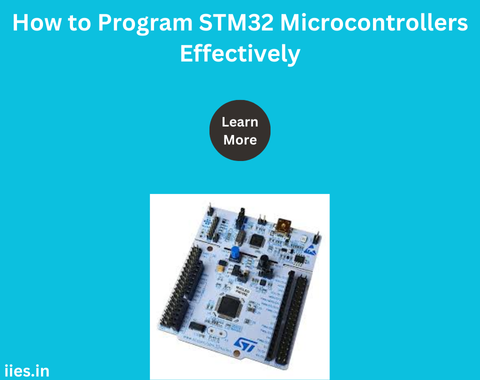1. Understanding the STM32 Ecosystem
The STM32 family comprises various series, each tailored for specific applications, ranging from ultra-low-power devices to high-performance microcontrollers. Key series include STM32F (mainstream), STM32L (ultra-low power), and STM32H (high-performance). Each series comes with its own set of peripherals, memory configurations, and processing capabilities.
Key Aspects to Consider:
- Core Architecture: STM32 microcontrollers are based on ARM Cortex-M cores, such as Cortex-M0, M3, M4, and M7. Understanding the core architecture is crucial for optimizing code execution and leveraging the full potential of the hardware.
- Peripherals: Familiarity with the available peripherals (e.g., GPIO, ADC, UART, SPI, I2C) is essential for effective hardware interfacing and control.
- Power Management: STM32 microcontrollers offer various power-saving modes. Understanding these modes allows developers to optimize power consumption, especially in battery-powered applications.
2. Setting Up the Development Environment
A well-configured development environment is critical for efficient STM32 programming. The key components of this environment include:
Integrated Development Environment (IDE):
- STM32CubeIDE: This is the official IDE provided by STMicroelectronics. It integrates code editing, compilation, debugging, and device configuration into a single platform.
- Third-Party IDEs: Alternatives like Keil MDK, IAR Embedded systems, and Atollic TrueSTUDIO are also popular among STM32 developers.
STM32CubeMX:
- Purpose: STM32CubeMX is a graphical tool that simplifies microcontroller configuration, including pin assignments, clock settings, and peripheral initialization.
- Code Generation: After configuring the microcontroller, STM32CubeMX generates initialization code that can be seamlessly integrated into your project.
Toolchain:
- GCC-Based Toolchains: Many developers prefer GCC-based toolchains due to their open-source nature. These toolchains can be used with IDEs like STM32CubeIDE.
- Proprietary Toolchains: Tools like Keil MDK provide highly optimized compilers and advanced debugging features but may come at a higher cost.
3. Programming Techniques and Best Practices
Effective STM32 programming involves a combination of good coding practices, understanding the hardware, and leveraging available tools.
Modular Programming:
- Functionality Segmentation: Divide your code into modular functions and files. This practice enhances code readability, maintainability, and reusability.
- Peripheral Abstraction: Create drivers or libraries to abstract the complexity of direct peripheral manipulation. This abstraction allows for easier updates and code portability.
Interrupt Management:
- Efficient Use of Interrupts: Interrupts are essential for handling time-sensitive tasks. Prioritize interrupt-driven programming for critical functions, while ensuring non-blocking operations for other tasks.
- Interrupt Prioritization: STM32 microcontrollers support nested interrupts. Properly configure interrupt priorities to avoid conflicts and ensure that critical tasks are executed in a timely manner.
Memory Management:
- Efficient Memory Use: Understand the memory architecture (Flash, SRAM) of your STM32 microcontroller. Optimize the use of these memories to ensure efficient execution and minimal resource wastage.
- DMA Utilization: Direct Memory Access (DMA) can significantly reduce CPU load by handling data transfers between peripherals and memory. Effectively use DMA channels to optimize data handling.
Power Optimization:
- Low-Power Modes: Utilize low-power modes like Sleep, Stop, and Standby to reduce power consumption. Carefully manage the transitions between these modes to balance power efficiency and performance.
- Clock Management: Adjust the clock frequency dynamically based on the processing needs of your application. Lower clock speeds can reduce power consumption during less demanding operations.
4. Debugging and Testing Strategies
A robust debugging and testing strategy is vital for ensuring the reliability and performance of your STM32-based applications.
Debugging Tools:
- On-Chip Debugging: STM32 microcontrollers support on-chip debugging through SWD (Serial Wire Debug) or JTAG interfaces. Use tools like ST-Link or J-Link for real-time debugging.
- Debugging Features: Leverage features like breakpoints, watchpoints, and variable monitoring to analyze code execution and identify issues.
Unit Testing:
- Test-Driven Development: Implement unit tests to verify the functionality of individual code modules. This approach helps in catching bugs early in the development cycle.
- Automated Testing: Consider integrating automated testing frameworks to continuously validate the performance and reliability of your code.
Peripheral Simulation:
- Simulators: Some IDEs and tools offer peripheral simulation capabilities, allowing you to test your code without actual hardware. This can be useful in the early stages of development.
5. Leveraging STM32 Community and Resources
The STM32 ecosystem is supported by a vast community of developers, resources, and documentation.
Official Resources:
- Datasheets and Reference Manuals: Thoroughly study the datasheets and reference manuals for your specific STM32 microcontroller. These documents provide detailed information on the hardware and peripheral specifications.
- Application Notes: STMicroelectronics provides application notes that offer insights into specific use cases and advanced programming techniques.
Community Support:
- Forums and Online Communities: Engage with STM32 developer communities on platforms like ST Community, Stack Overflow, and GitHub. These communities are valuable sources of knowledge, troubleshooting tips, and code examples.
- Open-Source Projects: Explore open-source projects and libraries to accelerate your development process. Many STM32 developers share their code on platforms like GitHub, providing a wealth of resources to build upon.
